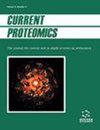围产期窒息后肺损伤新生儿血清外泌体的蛋白质组学分析
IF 0.5
4区 生物学
Q4 BIOCHEMICAL RESEARCH METHODS
引用次数: 0
摘要
新生儿肺损伤是围产期窒息后的常见现象。目的:评价围产期窒息后肺损伤子代血清外泌体的蛋白质组学特征。围产期窒息性肺损伤新生儿在出生后12 h、24 h和72 h采集血清样本。分离外泌体,测定其浓度和大小分布。Western blot检测外泌体表面标志物CD9、CD63、CD81、HSP70和TSG101。采用串联质量标签(TMT)对外泌体蛋白进行定量蛋白质组学分析。所有鉴定的蛋白均提交加权基因共表达网络分析(WGCNA)、GO功能和KEGG通路分析。利用Cytoscape的Cytohubba插件,利用蛋白-蛋白相互作用网络(PPI)对枢纽蛋白进行鉴定。外泌体为圆形或椭圆形的囊泡结构,直径范围在100 ~ 200 nm,大小分布标准一致。检测外泌体表面标志物CD9、CD63、CD81、HSP70和TSG101。在450个蛋白质中,有444个被标记上了基因名称。含有71种蛋白质的棕色模块与12 h表型高度相关,主要集中在脂蛋白和补体活化中。前10位蛋白APOA1、APOB、APOE、LPA、APOA2、CP、C3、FGB、FGA和TF被确定为枢纽蛋白。本研究为了解围产期窒息后肺损伤的分子变化提供了全面的信息,为临床筛选潜在的生物标志物和治疗靶点提供了可靠的依据。本文章由计算机程序翻译,如有差异,请以英文原文为准。
Proteome Profiling of Serum Exosomes from Newborns with Lung Injury after Perinatal Asphyxia
Neonate lung injury is a common phenomenon after perinatal asphyxia
To evaluate proteomic profiles of exosomes isolated from lung injury offspring serum after perinatal asphyxia.
Serum samples were collected at 12 h, 24 h, and 72 h after birth in neonates with perinatal asphyxia-induced lung injury. Exosomes were isolated, and the concentration and size distribution were assessed. The exosome surface markers CD9, CD63, CD81, HSP70, and TSG101 were detected by Western blot. The exosome proteins were evaluated by quantitative proteomics using a tandem mass tag (TMT). All the identified proteins were submitted to the Weighted Gene Co-Expression Network Analysis (WGCNA), GO function, and KEGG pathway analysis. A protein-protein interaction network (PPI) was utilized to identify hub proteins with the Cytohubba plugin of Cytoscape.
The exosomes were round or oval vesicular structures at a diameter range of 100-200 nm, and the size distribution was standard and consistent. Exosome surface markers CD9, CD63, CD81, HSP70, and TSG101 were detected. 444 out of 450 proteins were mapped with gene names. A brown module containing 71 proteins was highly linked with the 12 h phenotype and was predominantly concentrated in lipoprotein and complement activation. The top 10 proteins, APOA1, APOB, APOE, LPA, APOA2, CP, C3, FGB, FGA, and TF, were determined as hub proteins.
The present study demonstrates comprehensive information for understanding molecular changes of lung injury following perinatal asphyxia, which provides a reliable basis for screening potential biomarkers and therapeutic targets in the clinic.
求助全文
通过发布文献求助,成功后即可免费获取论文全文。
去求助
来源期刊

Current Proteomics
BIOCHEMICAL RESEARCH METHODS-BIOCHEMISTRY & MOLECULAR BIOLOGY
CiteScore
1.60
自引率
0.00%
发文量
25
审稿时长
>0 weeks
期刊介绍:
Research in the emerging field of proteomics is growing at an extremely rapid rate. The principal aim of Current Proteomics is to publish well-timed in-depth/mini review articles in this fast-expanding area on topics relevant and significant to the development of proteomics. Current Proteomics is an essential journal for everyone involved in proteomics and related fields in both academia and industry.
Current Proteomics publishes in-depth/mini review articles in all aspects of the fast-expanding field of proteomics. All areas of proteomics are covered together with the methodology, software, databases, technological advances and applications of proteomics, including functional proteomics. Diverse technologies covered include but are not limited to:
Protein separation and characterization techniques
2-D gel electrophoresis and image analysis
Techniques for protein expression profiling including mass spectrometry-based methods and algorithms for correlative database searching
Determination of co-translational and post- translational modification of proteins
Protein/peptide microarrays
Biomolecular interaction analysis
Analysis of protein complexes
Yeast two-hybrid projects
Protein-protein interaction (protein interactome) pathways and cell signaling networks
Systems biology
Proteome informatics (bioinformatics)
Knowledge integration and management tools
High-throughput protein structural studies (using mass spectrometry, nuclear magnetic resonance and X-ray crystallography)
High-throughput computational methods for protein 3-D structure as well as function determination
Robotics, nanotechnology, and microfluidics.
 求助内容:
求助内容: 应助结果提醒方式:
应助结果提醒方式:


